Evaluation of Protected Areas in Côte d’Ivoire and Ghana, West Africa, Using a Remote Sensing-Based Approach
Abstract
:1. Introduction
2. Materials and Methods
2.1. Site Descriptions
2.1.1. Ghana’s Protected Areas
2.1.2. Côte d’Ivoire’s Protected Areas
2.2. Data Sources
2.3. Spatial Analyses
2.4. Comparison Index
2.5. Statistical Summaries
3. Results
3.1. Ecoregion Representation
3.2. Slope Representation
3.3. Representation of Threatened Mammal Species
3.4. Human Modification
3.5. Agricultural Expansion Potential
4. Discussion
5. Conclusions
Author Contributions
Funding
Institutional Review Board Statement
Informed Consent Statement
Data Availability Statement
Acknowledgments
Conflicts of Interest
References
- Cotillon, S.E.; Tappan, G.G. Landscapes of West Africa: A Window on a Changing World; USGS: Garretson, SD, USA, 2016. [Google Scholar]
- Joppa, L.N.; Loarie, S.R.; Pimm, S.L. On the protection of “protected areas”. Proc. Natl. Acad. Sci. USA 2008, 105, 6673–6678. [Google Scholar] [CrossRef] [PubMed] [Green Version]
- Dudley, N. Guidelines for Applying Protected Area Management Categories; IUCN: Gland, Switzerland, 2008. [Google Scholar]
- Nelson, A.; Chomitz, K.M. Effectiveness of strict vs. multiple use protected areas in reducing tropical forest fires: A global analysis using matching methods. PLoS ONE 2011, 6, e22722. [Google Scholar] [CrossRef] [PubMed]
- Bradshaw, C.J.A.; Craigie, I.; Laurance, W.F. National emphasis on high-level protection reduces risk of biodiversity decline in tropical forest reserves. Biol. Conserv. 2015, 190, 115–122. [Google Scholar] [CrossRef]
- Mallon, D.P.; Hoffmann, M.; Grainger, M.J.; Hibert, F.; Van Vliet, N.; McGowan, P.J.K. An IUCN situation analysis of terrestrial and freshwater fauna in West and Central Africa. Occas. Pap. IUCN Species Surviv. Comm. 2015, 54, 40. [Google Scholar]
- Locke, H.; Dearden, P. Rethinking protected area categories and the new paradigm. Environ. Conserv. 2005, 32, 1–10. [Google Scholar] [CrossRef]
- Gardner, C.J. IUCN management categories fail to represent new, multiple-use protected areas in Madagascar. Oryx 2011, 45, 336–346. [Google Scholar] [CrossRef] [Green Version]
- Shafer, C.L. Arguments for and against IUCN protected area management category VI with a review of state versus community governance. J. Nat. Conserv. 2020, 53, 125697. [Google Scholar] [CrossRef]
- Geldmann, J.; Manica, A.; Burgess, N.D.; Coad, L.; Balmford, A. A global-level assessment of the effectiveness of protected areas at resisting anthropogenic pressures. Proc. Natl. Acad. Sci. USA 2019, 116, 23209–23215. [Google Scholar] [CrossRef]
- Porter-Bolland, L.; Ellis, E.A.; Guariguata, M.R.; Ruiz-Mallén, I.; Negrete-Yankelevich, S.; Reyes-García, V. Community managed forests and forest protected areas: An assessment of their conservation effectiveness across the tropics. For. Ecol. Manag. 2012, 268, 6–17. [Google Scholar] [CrossRef]
- Leroux, S.J.; Krawchuk, M.A.; Schmiegelow, F.; Cumming, S.G.; Lisgo, K.; Anderson, L.G.; Petkova, M. Global protected areas and IUCN designations: Do the categories match the conditions? Biol. Conserv. 2010, 143, 609–616. [Google Scholar] [CrossRef]
- Chardonnet, B. Reconfiguring the protected areas in Africa. Int. Union Conserv. Nat. Nat. Resour. 2019. Available online: https://conservationaction.co.za/wp-content/uploads/2019/03/etudesAP_configAP_EN.pdf (accessed on 1 January 2022).
- Juffe-Bignoli, D.; Burgess, N.D.; Bingham, H.; Belle, E.M.S.; De Lima, M.G.; Deguignet, M.; Bertzky, B.; Milam, A.N.; Martinez-Lopez, J.; Lewis, E.; et al. Protected Planet Report 2018; UNEP-WCMC, IUCN NGS: Cambridge, UK, 2018. [Google Scholar]
- Grooten, M.; Almond, R.E. Living Planet Report; World Wide Fund for Nature: Gland, Switzerland, 2018. [Google Scholar]
- Brondizio, E.S.; Settele, J.; Díaz, S.; Ngo, H.T. Global Assessment Report on Biodiversity and Ecosystem Services of the Intergovernmental Science-Policy Platform on Biodiversity and Ecosystem Services. 2019. Available online: https://ipbes.net/sites/default/files/2020-02/ipbes_global_assessment_report_summary_for_policymakers_en.pdf (accessed on 1 January 2022).
- Austin, M.P.; Margules, C.R. Assessing representativeness. In Wildlife Conservation Evaluation; Usher, M.B., Ed.; Chapman and Hall: London, UK, 1986; pp. 45–67. [Google Scholar]
- Olson, D.M.; Dinerstein, E. The Global 200: A representation approach to conserving the Earth’s most biologically valuable ecoregions. Conserv. Biol. 1998, 12, 502–515. [Google Scholar] [CrossRef] [Green Version]
- Trisurat, Y. Applying gap analysis and a comparison index to evaluate protected areas in Thailand. Environ. Manag. 2007, 39, 235–245. [Google Scholar] [CrossRef] [PubMed]
- Malcolm, J.R.; Liu, C.; Miller, L.B.; Allnutt, T.; Hansen, L. Habitats at Risk. Global Warming and Species Loss in Globally Significant Terrestrial Ecosystems. World Wide Fund for Nature. 2002. Available online: https://digital.library.unt.edu/ark:/67531/metadc226787/ (accessed on 1 January 2022).
- Kareiva, P.; Marvier, M. Conserving biodiversity coldspots: Recent calls to direct conservation funding to the world’s biodiversity hotspots may be bad investment advice. Am. Sci. 2003, 91, 344–351. [Google Scholar] [CrossRef]
- Hazen, H.D.; Anthamatten, P.J. Representation of ecological regions by protected areas at the global scale. Phys. Geogr. 2004, 25, 499–512. [Google Scholar] [CrossRef]
- Sayre, R.; Karagulle, D.; Frye, C.; Boucher, T.; Wolff, N.H.; Breyer, S.; Wright, D.; Martin, M.; Butler, K.; Van Graafeiland, K.; et al. An assessment of the representation of ecosystems in global protected areas using new maps of World Climate Regions and World Ecosystems. Glob. Ecol. Conserv. 2020, 21, e00860. [Google Scholar] [CrossRef]
- Smith, R.J. West Africa Gap Analysis and Spatial Conservation Prioritisation. UNEP-WCMC Technical Report. Cambridge, UK. 2015. Available online: http://parcc.protectedplanet.net/system/comfy/cms/files/files/000/000/047/original/PARCC_DICE_Regional_Planning_System_Report_FINAL_EN.pdf (accessed on 1 January 2022).
- Singh, M.; Griaud, C.; Collins, C.M. An evaluation of the effectiveness of protected areas in Thailand. Ecol. Indic. 2021, 125, 107536. [Google Scholar] [CrossRef]
- Brugiere, D.; Kormos, R. Review of the protected area network in Guinea, West Africa, and recommendations for new sites for biodiversity conservation. Biodivers. Conserv. 2009, 18, 847–868. [Google Scholar] [CrossRef]
- Schmitt, C.B.; Burgess, N.D.; Coad, L.; Belokurov, A.; Besançon, C.; Boisrobert, L.; Campbell, A.; Fish, L.; Gliddon, D.; Humphries, K.; et al. Global analysis of the protection status of the world’s forests. Biol. Conserv. 2009, 142, 2122–2130. [Google Scholar] [CrossRef]
- Joppa, L.N.; Pfaff, A. High and far: Biases in the location of protected areas. PLoS ONE 2009, 4, e8273. [Google Scholar] [CrossRef]
- Venter, O.; Fuller, R.A.; Segan, D.B.; Carwardine, J.; Brooks, T.; Butchart, S.H.M.; Di Marco, M.; Iwamura, T.; Joseph, L.; O’Grady, D.; et al. Targeting global protected area expansion for imperiled biodiversity. PLoS Biol. 2014, 12, e1001891. [Google Scholar] [CrossRef] [PubMed] [Green Version]
- Green, J.M.H.; Larrosa, C.; Burgess, N.D.; Balmford, A.; Johnston, A.; Mbilinyi, B.P.; Platts, P.J.; Coad, L. Deforestation in an African biodiversity hotspot: Extent, variation and the effectiveness of protected areas. Biol. Conserv. 2013, 164, 62–72. [Google Scholar] [CrossRef]
- Badgley, C. Tectonics, topography, and mammalian diversity. Ecography 2010, 33, 220–231. [Google Scholar] [CrossRef]
- Tallowin, O.; Allison, A.; Algar, A.C.; Kraus, F.; Meiri, S. Papua New Guinea terrestrial-vertebrate richness: Elevation matters most for all except reptiles. J. Biogeogr. 2017, 44, 1734–1744. [Google Scholar] [CrossRef] [Green Version]
- Myers, N.; Mittermeier, R.A.; Mittermeier, C.G.; Da Fonseca, G.A.B.; Kent, J. Biodiversity hotspots for conservation priorities. Nature 2000, 403, 853–858. [Google Scholar] [CrossRef]
- Ernst, R.; Linsenmair, K.E.; Thomas, R.; Rödel, M.-O. Amphibian Communities in Disturbed Forests: Lessons from the Neo-and Afrotropics; Springer: Berlin/Heidelberg, Germany, 2007. [Google Scholar]
- Veach, V.; Di Minin, E.; Pouzols, F.M.; Moilanen, A. Species richness as criterion for global conservation area placement leads to large losses in coverage of biodiversity. Divers. Distrib. 2017, 23, 715–726. [Google Scholar] [CrossRef] [Green Version]
- Rodrigues, A.S.L.; Akcakaya, H.R.; Andelman, S.J.; Bakarr, M.I.; Boitani, L.; Brooks, T.M.; Chanson, J.S.; Fishpool, L.D.C.; Da Fonseca, G.A.B.; Gaston, K.J.; et al. Global gap analysis: Priority regions for expanding the global protected-area network. Bioscience 2004, 54, 1092–1100. [Google Scholar] [CrossRef]
- Rodrigues, A.S.L.; Andelman, S.J.; Bakarr, M.I.; Boitani, L.; Brooks, T.M.; Cowling, R.M.; Fishpool, L.D.C.; Da Fonseca, G.A.B.; Gaston, K.J.; Hoffmann, M.; et al. Effectiveness of the global protected area network in representing species diversity. Nature 2004, 428, 640–643. [Google Scholar] [CrossRef]
- Craigie, I.D.; Baillie, J.E.M.; Balmford, A.; Carbone, C.; Collen, B.; Green, R.E.; Hutton, J.M. Large mammal population declines in Africa’s protected areas. Biol. Conserv. 2010, 143, 2221–2228. [Google Scholar] [CrossRef]
- Shafer, C.L. Cautionary thoughts on IUCN protected area management categories V–VI. Glob. Ecol. Conserv. 2015, 3, 331–348. [Google Scholar] [CrossRef] [Green Version]
- Malhi, Y.; Adu-Bredu, S.; Asare, R.A.; Lewis, S.L.; Mayaux, P. The past, present and future of Africa’s rainforests. Philos. Trans. R. Soc. B Biol. Sci. 2013, 368, 20120293. [Google Scholar] [CrossRef] [PubMed] [Green Version]
- Abiem, I.; Arellano, G.; Kenfack, D.; Chapman, H. Afromontane forest diversity and the role of grassland-forest transition in tree species distribution. Diversity 2020, 12, 30. [Google Scholar] [CrossRef] [Green Version]
- Pacifici, M.; Di Marco, M.; Watson, J.E.M. Protected areas are now the last strongholds for many imperiled mammal species. Conserv. Lett. 2020, 13, 1–7. [Google Scholar] [CrossRef]
- Rija, A.A.; Critchlow, R.; Thomas, C.D.; Beale, C.M. Global extent and drivers of mammal population declines in protected areas under illegal hunting pressure. PLoS ONE 2020, 15, e0227163. [Google Scholar] [CrossRef]
- Oberosler, V.; Tenan, S.; Zipkin, E.F.; Rovero, F. Poor management in protected areas is associated with lowered tropical mammal diversity. Anim. Conserv. 2020, 23, 171–181. [Google Scholar] [CrossRef]
- Brum, F.T.; Graham, C.H.; Costa, G.C.; Hedges, S.B.; Penone, C.; Radeloff, V.C.; Rondinini, C.; Loyola, R.; Davidson, A.D. Global priorities for conservation across multiple dimensions of mammalian diversity. Proc. Natl. Acad. Sci. USA 2017, 114, 7641–7646. [Google Scholar] [CrossRef] [Green Version]
- González-Maya, J.F.; Víquez-R, L.R.; Belant, J.L.; Ceballos, G. Effectiveness of protected areas for representing species and populations of terrestrial mammals in Costa Rica. PLoS ONE 2015, 10, e0124480. [Google Scholar] [CrossRef] [PubMed] [Green Version]
- Hackman, K.O. The state of biodiversity in Ghana: Knowledge gaps and prioritization. Int. J. Biodivers. Conserv. 2014, 6, 681–701. [Google Scholar] [CrossRef]
- Kerr, J.T.; Ostrovsky, M. From space to species: Ecological applications for remote sensing. Trends Ecol. Evol. 2003, 18, 299–305. [Google Scholar] [CrossRef]
- IUCN/PACO. Parks and Reserves of Ghana: Management Effectiveness Assessment of Protected Areas; IUCN/PACO: Ouagadougou, Burkina Faso, 2010. [Google Scholar]
- Norris, K.; Asase, A.; Collen, B.; Gockowksi, J.; Mason, J.; Phalan, B.; Wade, A. Biodiversity in a forest-agriculture mosaic–The changing face of West African rainforests. Biol. Conserv. 2010, 143, 2341–2350. [Google Scholar] [CrossRef]
- Dyer, M. Ornithological Perspectives, Annex 4 in Ankasa Conservation Area Management Plan; ULG Northumbrian Ltd.: Durham, NC, USA, 1997; p. 62. [Google Scholar]
- Obour, R.; Amankwaa, D.; Asare, A. Illegal rattan extraction trends in the Ankasa Conservation Area in Ghana. J. Energy Nat. Resour. Manag. 2015, 2. [Google Scholar] [CrossRef]
- Population Total Ghana 2020. Available online: https://data.worldbank.org/indicator/SP.POP.TOTL?locations=GH (accessed on 5 January 2022).
- Janssen, T.A.J.; Ametsitsi, G.K.D.; Collins, M.; Adu-Bredu, S.; Oliveras, I.; Mitchard, E.T.A.; Veenendaal, E.M. Extending the baseline of tropical dry forest loss in Ghana (1984–2015) reveals drivers of major deforestation inside a protected area. Biol. Conserv. 2018, 218, 163–172. [Google Scholar] [CrossRef]
- Ayivor, J.S.; Gordon, C.; Tobin, G.A.; Ntiamoa-Baidu, Y. Evaluation of management effectiveness of protected areas in the Volta Basin, Ghana: Perspectives on the methodology for evaluation, protected area financing and community participation. J. Environ. Policy Plan. 2020, 22, 239–255. [Google Scholar] [CrossRef]
- Campbell, G.; Kuehl, H.; Kouamé, P.N.; Boesch, C. Alarming decline of West African chimpanzees in Côte d’Ivoire. Curr. Biol. 2008, 18, R903–R904. [Google Scholar] [CrossRef] [Green Version]
- Ehuitché, B.T. An analysis of dynamics of deforestation and agricultural productivity in Côte d’Ivoire. Int. Res. J. Agric. Sci. Soil Sci. 2015, 5, 103–111. [Google Scholar] [CrossRef]
- Population Total Cote D’Ivoire. Available online: https://data.worldbank.org/indicator/SP.POP.TOTL?locations=CI (accessed on 5 January 2022).
- Download Data by Country. Available online: https://diva-gis.org/gdata (accessed on 1 January 2022).
- Analysing Data on Protected Areas. Available online: https://www.oecd.org/environment/indicators-modelling-outlooks/OECD-Protected-Areas-Brochure-2019-web.pdf (accessed on 1 January 2022).
- Ecoregional Conservation: A Comprehensive Approach to Conserving Biodiversity. Available online: https://www.conservationgateway.org/ConservationByGeography/NorthAmerica/UnitedStates/edc/Documents/ED_terrestrial_ERAs_ecoregconserve.pdf (accessed on 1 January 2022).
- SRTM 90m DEM Digital Elevation Database. Available online: http://srtm.csi.cgiar.org (accessed on 1 January 2022).
- SEDAC. Gridded Species Distribution: Global Amphibian Richness Grids. Part A; NASA Socioeconomic Data and Applications Center (SEDAC): Palisades, NY, USA, 2015.
- Kennedy, C.M.; Oakleaf, J.R.; Theobald, D.M.; Baruch-Mordo, S.; Kiesecker, J. Global Human Modification of Terrestrial Systems; NASA Socioeconomic Data and Applications Center (SEDAC): Palisades, NY, USA, 2020; Volume 10. [CrossRef]
- Reis, M.; Bolat, N.; Dutal, H.; Abız, B. Producing Erosion Risk Map Using Remote Sensing Techniques and RUSLE Method in Halfalı Stream Watershed of Kahramanmaras. Kastamonu Univ. J. For. Fac. 2017, 17, 176–185. [Google Scholar] [CrossRef] [Green Version]
- Oakleaf, J.R.; Kennedy, C.M.; Baruch-Mordo, S.; West, P.C.; Gerber, J.S.; Jarvis, L.; Kiesecker, J. Development Threat Index; NASA Socioeconomic Data and Applications Center (SEDAC): Palisades, NY, USA, 2019. [CrossRef]
- Shrestha, U.B.; Shrestha, S.; Chaudhary, P.; Chaudhary, R.P. How representative is the protected areas system of Nepal? Mt. Res. Dev. 2010, 30, 282–294. [Google Scholar] [CrossRef]
- van Breugel, P.; Kindt, R.; Lillesø, J.-P.B.; van Breugel, M. Environmental gap analysis to prioritize conservation efforts in eastern Africa. PLoS ONE 2015, 10, e0121444. [Google Scholar] [CrossRef]
- Carr, J.; Adeleke, A.; Angu Angu, K.; Belle, E.; Burgess, N.; Carrizo, S.; Choimes, A.; Coulthard, N.; Darwall, W.; Foden, W.; et al. Ecosystem Profile Guinean Forests of West Africa Biodiversity Hotspot; Critical Ecosystem Partnership Fund: Arlington, VA, USA, 2015. [Google Scholar] [CrossRef]
- Naughton-Treves, L.; Holland, M.B.; Brandon, K. The role of protected areas in conserving biodiversity and sustaining local livelihoods. Annu. Rev. Environ. Resour. 2005, 30, 219–252. [Google Scholar] [CrossRef] [Green Version]
- Bruner, A.G.; Gullison, R.E.; Rice, R.E.; Fonseca, G.A.B. Da Effectiveness of parks in protecting tropical biodiversity. Science 2001, 291, 125–128. [Google Scholar] [CrossRef] [Green Version]
- Eshag, E.; Richards, P.J. A comparison of economic developments in Ghana and the Ivory Coast since 1960. Bull. Oxford Univ. Inst. Econ. Stat. 1967, 29, 353–372. [Google Scholar] [CrossRef]
- Savolainen, V.; Clottey, V.A.; Bi, T.S.D.; Konan, J.L.; Quain, M.; Bezeng, B.S.; Logah, V.; Kena, A.W.; Osekre, E.A.; Atuah, L.; et al. Systems thinking creates opportunities for a circular economy and sustainable palm agriculture in Africa. Curr. Res. Environ. Sustain. 2020, 1, 31–34. [Google Scholar] [CrossRef]
- Hilty, J.; Worboys, G.L.; Keeley, A.; Woodley, S.; Lausche, B.; Locke, H.; Carr, M.; Pulsford, I.; Pittock, J.; White, J.W.; et al. Guidelines for conserving connectivity through ecological networks and corridors. Best Pract. Prot. Area Guidel. Ser. 2020, 30, 30. [Google Scholar]
- Margules, C.R.; Pressey, R.L.; Williams, P.H. Representing biodiversity: Data and procedures for identifying priority areas for conservation. J. Biosci. 2002, 27, 309–326. [Google Scholar] [CrossRef] [PubMed]
- Egloff, W.; Agosti, D.; Patterson, D.; Hoffmann, A.; Mietchen, D.; Kishor, P.; Penev, L. Data policy recommendations for biodiversity data. EU BON Project Report. Res. Ideas Outcomes 2016, 2, e8458. [Google Scholar] [CrossRef] [Green Version]
- Howard, S.D.; Bickford, D.P. Amphibians over the edge: Silent extinction risk of Data Deficient species. Divers. Distrib. 2014, 20, 837–846. [Google Scholar] [CrossRef]
- Watson, J.E.M.; Keith, D.A.; Strassburg, B.B.N.; Venter, O.; Williams, B.; Nicholson, E. Set a global target for ecosystems. Nature 2020, 578, 360–362. [Google Scholar] [CrossRef] [Green Version]
- Peyre, G.; Balslev, H.; Font, X.; Tello, J.S. Fine-scale plant richness mapping of the Andean páramo according to macroclimate. Front. Ecol. Evol. 2019, 377. [Google Scholar] [CrossRef] [Green Version]
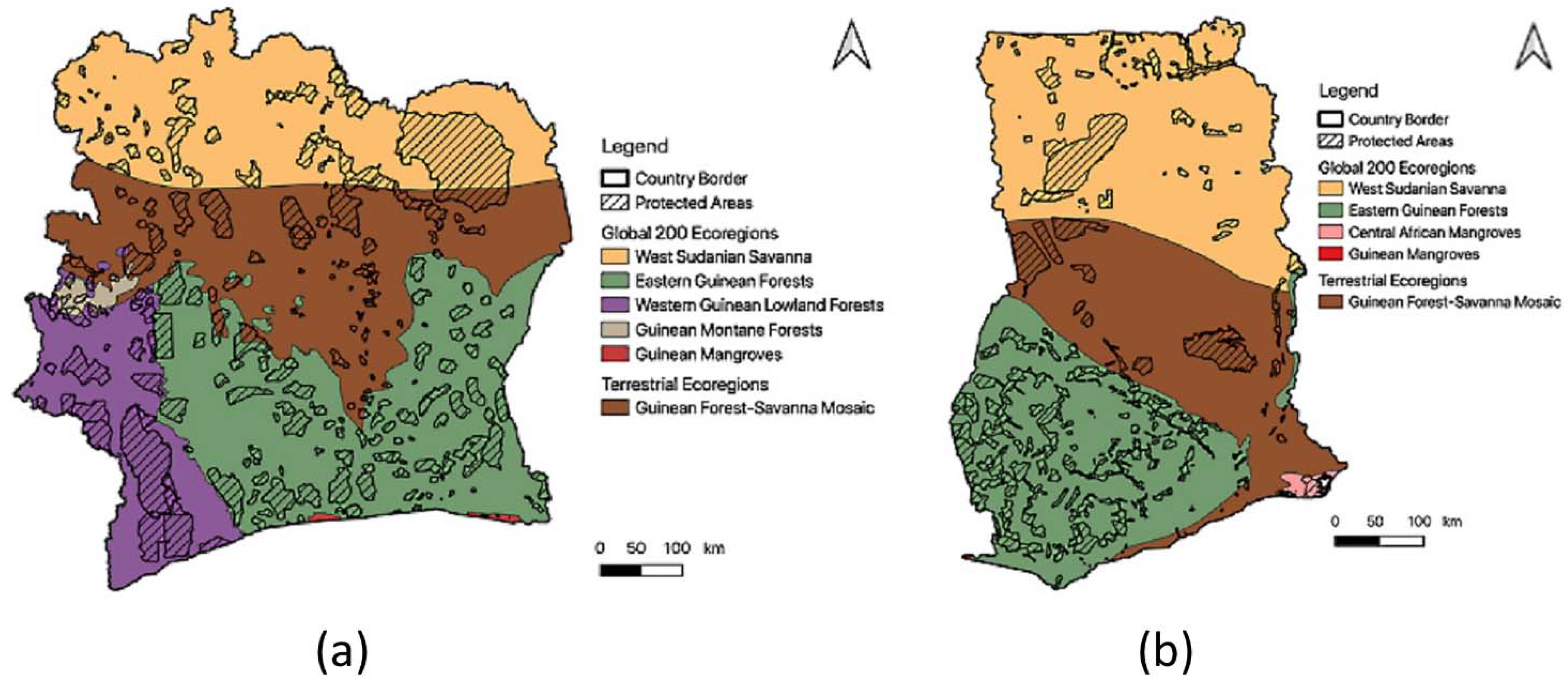
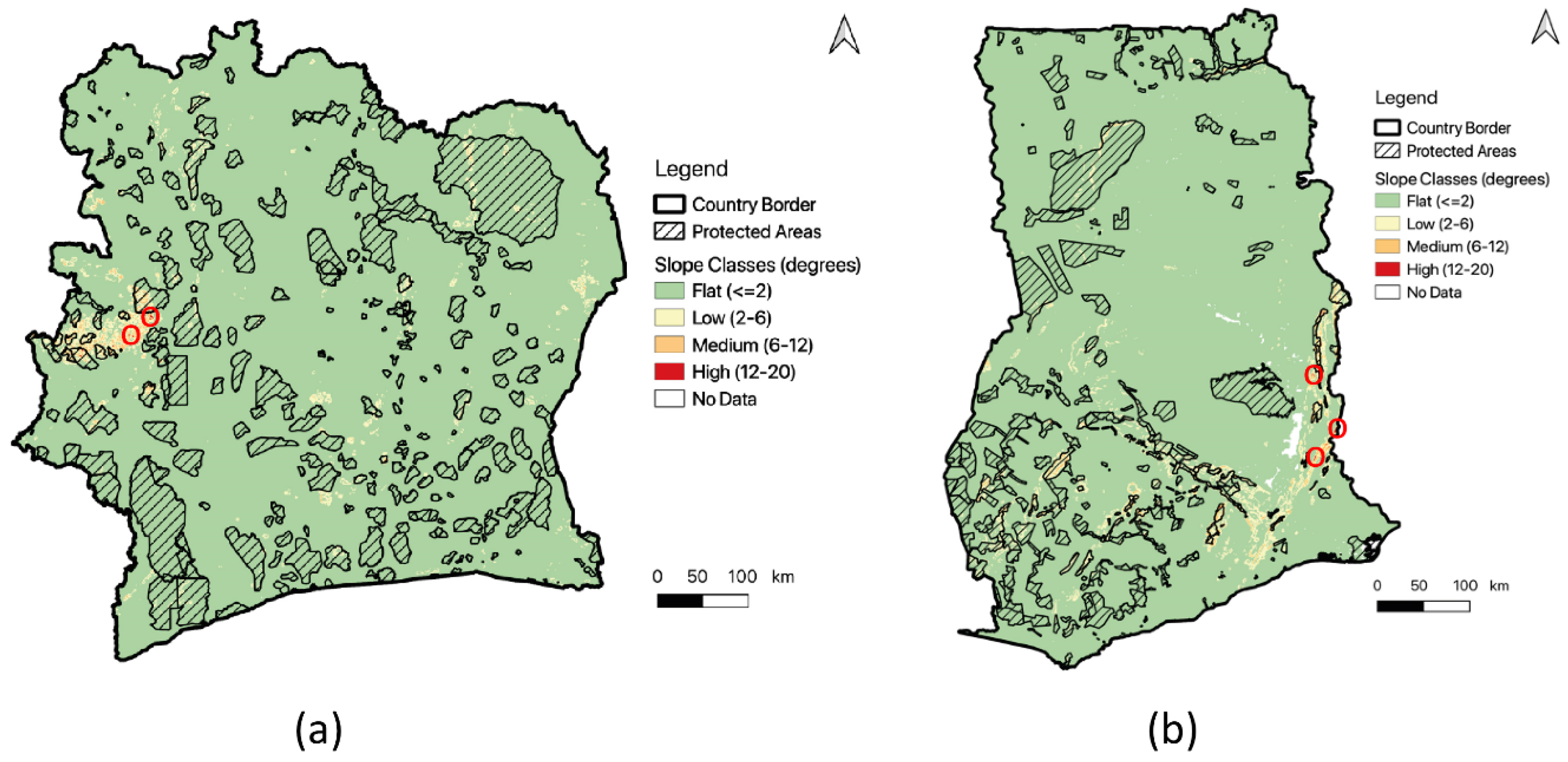
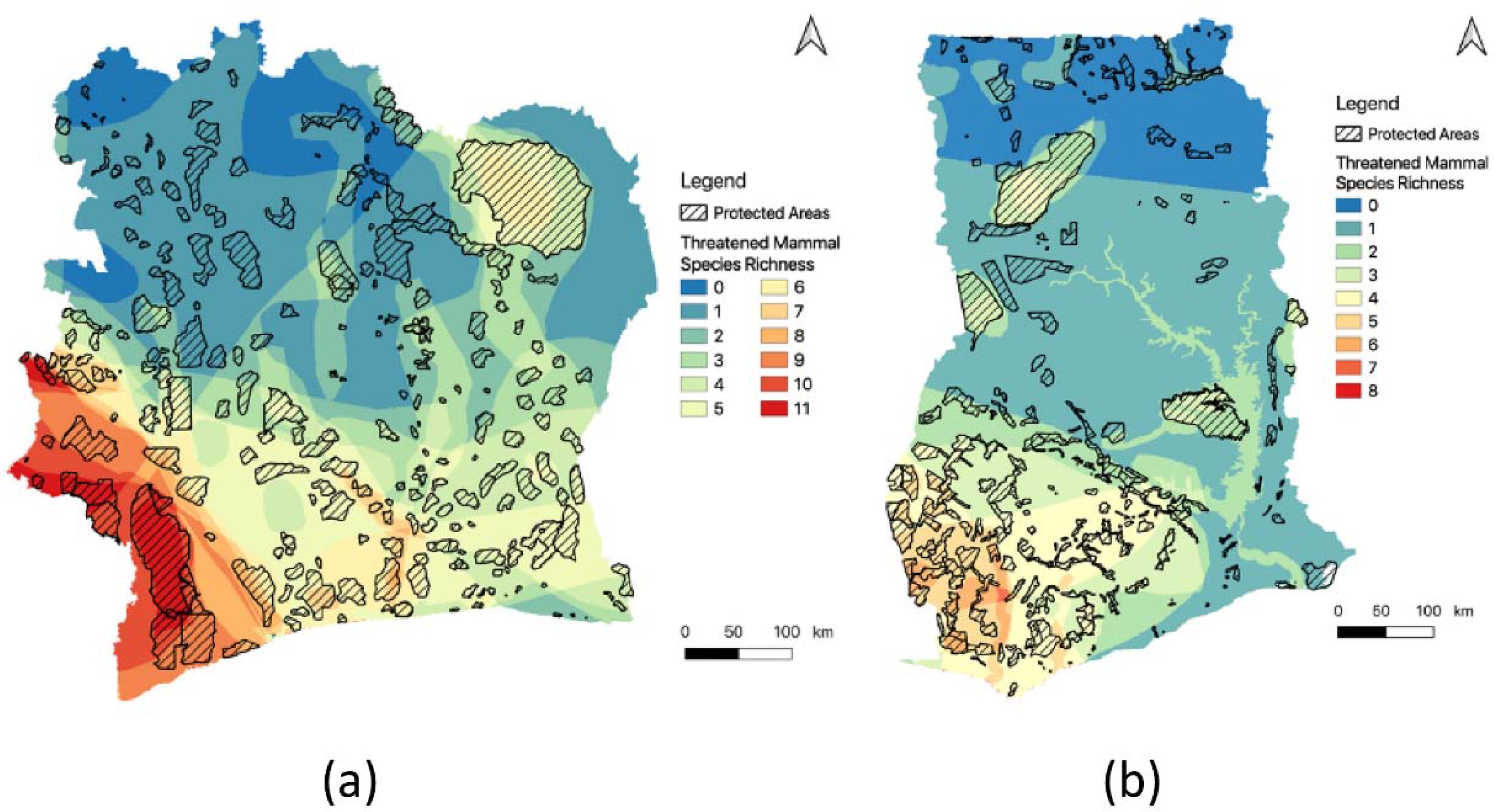
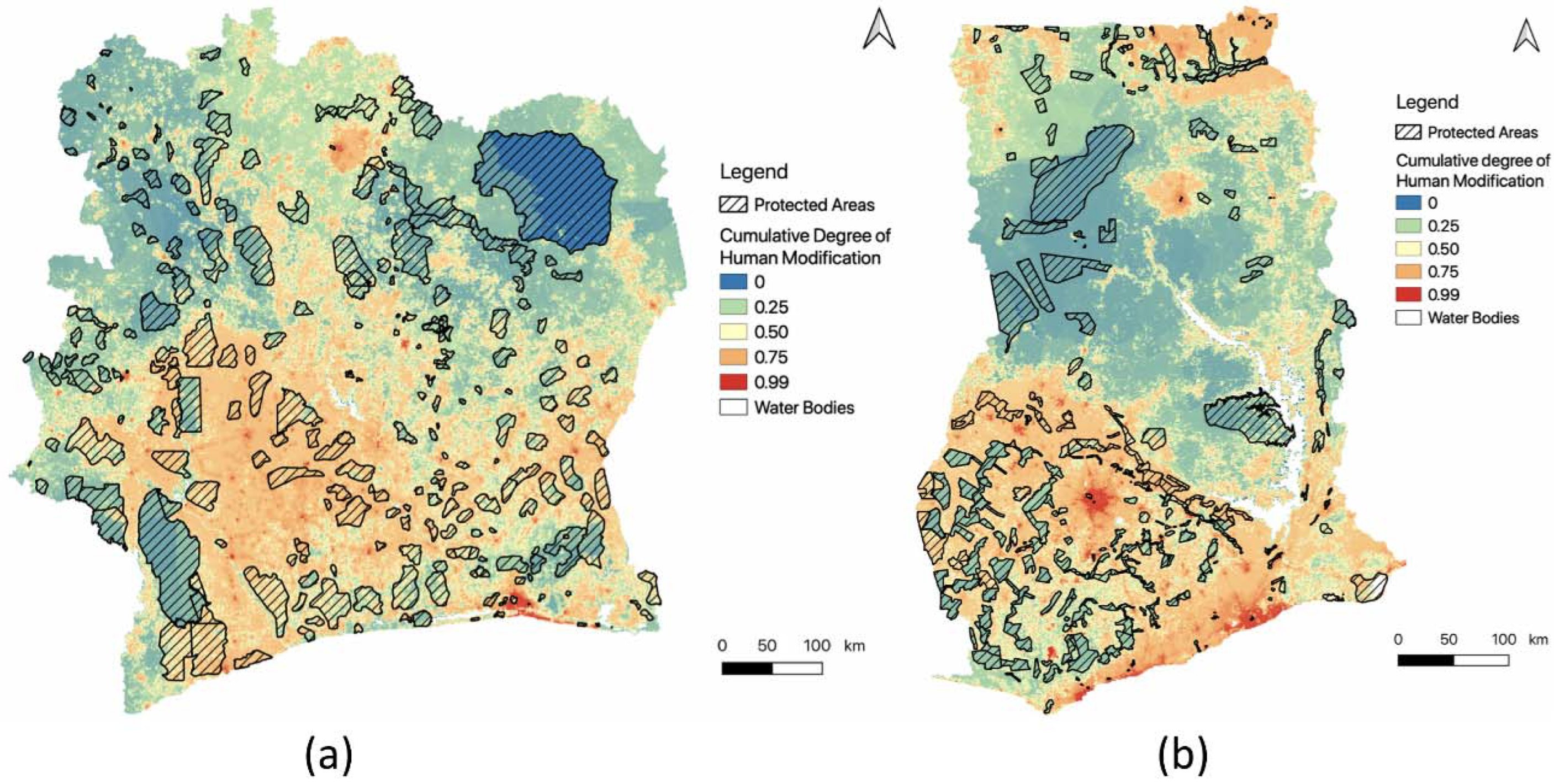
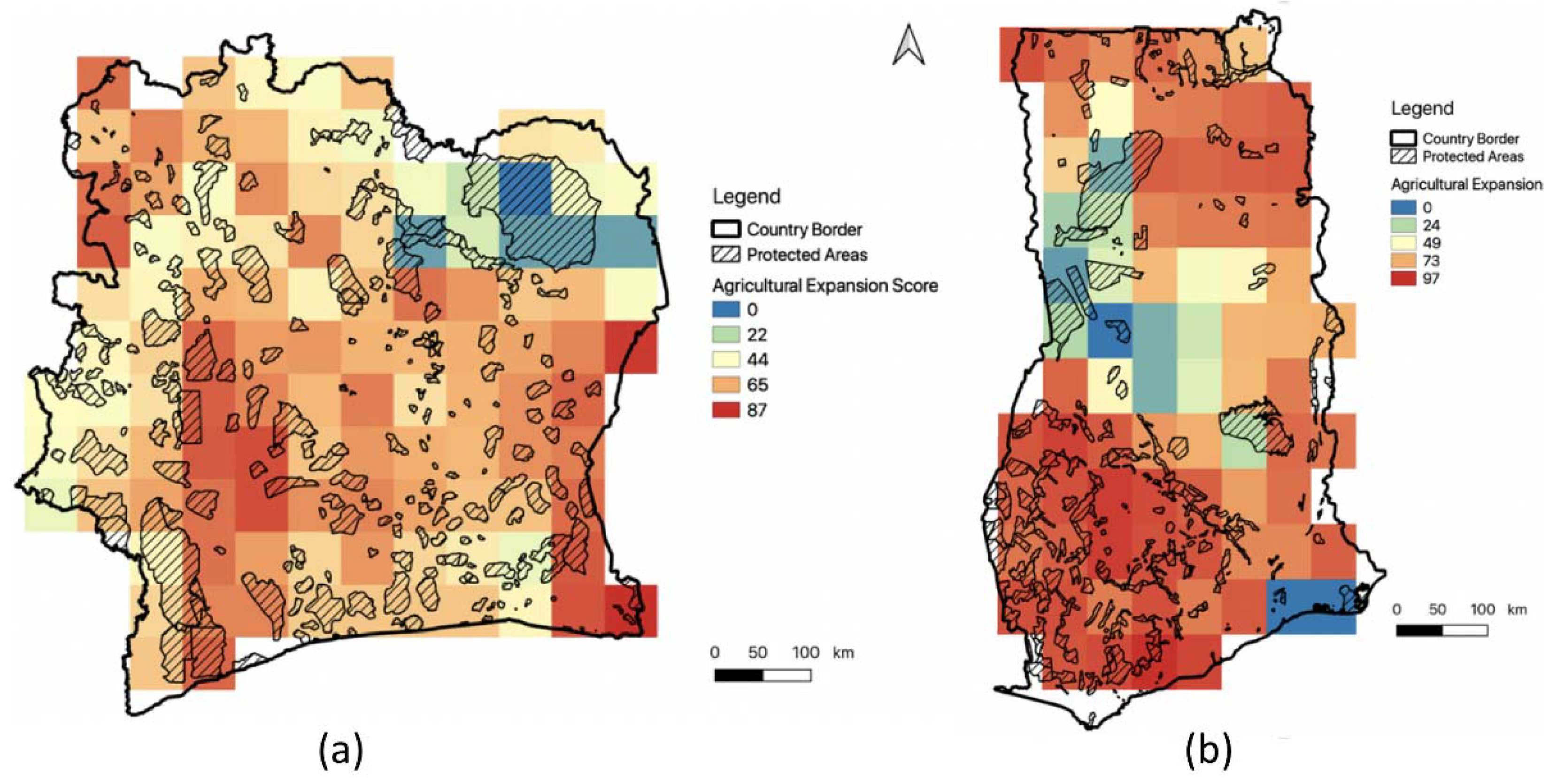
| Category | Description |
|---|---|
| Ia: Strict nature reserve | Strictly protected areas are set aside to protect biodiversity and also possibly geological/geomorphological features where human visitation, use, and impacts are strictly controlled and limited to ensure the protection of the conservation values. Such protected areas can serve as indispensable reference areas for scientific research and monitoring. |
| Ib: Wilderness area | Usually, large unmodified or slightly modified areas, retaining their natural character and influence, without permanent or significant human habitation, are protected and managed to preserve their natural condition. |
| II: National park | Large natural or near-natural areas are set aside to protect large-scale ecological processes, along with the complement of species and ecosystems characteristic of the area, which also provide a foundation for environmentally and culturally compatible spiritual, scientific, educational, recreational, and visitor opportunities. |
| III: Natural monument or feature | Set aside to protect a specific natural monument, which can be a landform, sea mount, submarine cavern, geological feature such as a cave, or even a living feature such as an ancient grove. They are generally quite small, protected areas and often have high visitor value. |
| IV: Habitat/species management | Aim to protect particular species or habitats and management reflects this priority. Many Category IV protected areas will need regular, active interventions to address the requirements of particular species or to maintain habitats, but this is not a requirement of the category. |
| V: Protected landscape or seascape | The interaction of people and nature over time has produced an area of distinct character with significant ecological, biological, cultural, and scenic value, where safeguarding the integrity of this interaction is vital to protecting and sustaining the area, its associated nature conservation, and other values. |
| VI: Protected area with sustainable use of natural resources | Conserve ecosystems and habitats, together with associated cultural values and traditional natural resource management systems. They are generally large, with most of the area in natural condition, where a proportion is under sustainable natural resource management and where low-level nonindustrial use of natural resources compatible with nature conservation is seen as one of the main aims of the area. |
| IUCN Category | Protection/Use Type | Simplified Human Access Grouping | Côte d’Ivoire, 238 PAs | Ghana, 284 PAs | ||
|---|---|---|---|---|---|---|
| Number of PAs | Area (km2) | Number of PAs | Area (km2) | |||
| Ia | Strict protection (Ia: Strict nature reserve, Ib: Wilderness area) | Low Human access is strictly limited except for low visitation of areas with religious/spiritual significance | 3 | 1322 | 1 | 376 |
| II | Ecosystem conservation and protection | Medium Permits for cultural, scientific, educational, recreational, and visitation purposes) | 9 | 19,710 | 10 | 10,928 |
| III | Conservation of natural features | - | - | 56 | 5312 | |
| IV | Conservation through active management | 3 | 492 | 81 | 9063 | |
| V | Landscape/seascape conservation and recreation | High Categories V and VI (multiple-use categories where human intervention is expected; allows sustainable natural resource management and extraction) | - | - | 6 | 349 |
| VI | Sustainable use of natural resources | - | - | 127 | 10,987 | |
| Not Reported | Local PAs such as forest reserves | N/A | 223 | 50,242 | 2 | 83 |
| Not Applicable | Other specific designations: World Heritage Sites or UNESCO Man and Biosphere (MAB) Reserves | N/A | - | - | 1 | 720 |
| Country | Côte d’Ivoire | Ghana | ||||
|---|---|---|---|---|---|---|
| Terrestrial Ecoregion | % of Land Area | % of PA | CI | % of Land Area | % of PA | CI |
| West Sudanian Savanna * | 26.52 | 21.52 | 0.82 | 37.78 | 11.97 | 0.32 |
| Guinean Forest–Savanna Mosaic | 27.88 | 15.10 | 0.54 | 29.19 | 12.02 | 0.41 |
| Eastern Guinean Forests * | 32.27 | 22.46 | 0.70 | 33.39 | 22.11 | 0.66 |
| Central African Mangroves * | 0.59 | 36.90 | 62.84 | |||
| Guinean Mangroves * | 0.19 | 4.91 | 25.55 | 0.01 | 0 | Not represented |
| Western Guinean Lowland Forests * | 13.62 | 36.01 | 2.64 | |||
| Guinean Montane Forests * | 0.92 | 24.43 | 26.62 | |||
| Country | Côte d’Ivoire | Ghana | |||
|---|---|---|---|---|---|
| Terrestrial Ecoregion | IUCN Category | % of PA | CI | % of PA | CI |
| West Sudanian Savanna * | II | 11.76 | 0.44 | 5.64 | 0.15 |
| III | 0.91 | 0.02 | |||
| V | 0.14 | 0.004 | |||
| IV | 2.63 | 0.07 | |||
| VI | 2.66 | 0.07 | |||
| Guinean Forest–Savanna Mosaic | Ia | 1.38 | 0.05 | 0.54 | 0.02 |
| II | 3.59 | 0.13 | 6.72 | 0.23 | |
| III | 0.37 | 0.01 | |||
| IV | 0.23 | 0.01 | 2.41 | 0.08 | |
| VI | 1.97 | 0.07 | |||
| Eastern Guinean Forests * | Ia | 0.03 | 0.001 | ||
| II | 0.83 | 0.03 | 1.37 | 0.04 | |
| III | 5.27 | 0.16 | |||
| IV | 0.00 | 0.00 | 6.20 | 0.19 | |
| V | 0.28 | 0.01 | |||
| VI | 8.97 | 0.27 | |||
| Western Guinean Lowland Forests * | Ia | 0.05 | 0.003 | ||
| II | 12.55 | 0.92 | |||
| IV | 0.64 | 0.05 | |||
| Guinean Montane Forests * | Ia | 0.85 | 0.92 | ||
| II | 2.02 | 2.20 | |||
| Guinean Mangroves * | II | 1.18 | 6.14 | ||
| Country | Côte d’Ivoire | Ghana | ||||
|---|---|---|---|---|---|---|
| Slope Classification (Degrees) | % of Land Area | % of PA | CI | % of Land Area | % of PA | CI |
| Flat (0–2) | 96.93 | 13.81 | 0.14 | 93.88 | 19.70 | 0.21 |
| Low (>2–6) | 2.65 | 22.31 | 8.42 | 4.34 | 30.95 | 7.13 |
| Medium (>6–12) | 0.40 | 32.48 | 80.74 | 0.74 | 51.26 | 69 |
| High (>12–20) | 0.01 | 58.49 | 4439.48 | 0.02 | 50.66 | 2389.14 |
| Country | Côte d’Ivoire | Ghana | |||
|---|---|---|---|---|---|
| Slope Classification (Degrees) | IUCN Category | % of PA | CI | % of PA | CI |
| Flat (0–2) | Ia | 0.41 | 0.004 | 0.17 | 0.002 |
| II | 0.63 | 0.007 | 0.97 | 0.01 | |
| III | 4.95 | 0.05 | |||
| IV | 0.06 | 0.001 | 6.19 | 0.07 | |
| V | 0.26 | 0.003 | |||
| VI | 7.12 | 0.08 | |||
| Low (>2–6) | Ia | 0.21 | 0.08 | ||
| II | 6.36 | 2.40 | 5.34 | 1.23 | |
| III | 5.79 | 1.33 | |||
| IV | 0.25 | 0.10 | 8.30 | 1.91 | |
| V | 0.12 | 0.03 | |||
| VI | 11.39 | 2.63 | |||
| Medium (>6–12) | Ia | 1.39 | 3.44 | ||
| II | 11.30 | 28.02 | 4.16 | 5.60 | |
| 24.59 | 33.10 | ||||
| 13.30 | 17.90 | ||||
| 9.21 | 12.40 | ||||
| High (>12–20) | Ia | 20.14 | 1529.05 | ||
| II | 10.10 | 766.42 | |||
| III | 37.17 | 17.52 | |||
| IV | 13.49 | 636.25 | |||
| Côte d’Ivoire | Ghana | |||||
|---|---|---|---|---|---|---|
| IUCN Category | Threatened Mammal Species Richness | |||||
| Median | Mean | CI | Median | Mean | CI | |
| Ia | 6 | 6.38 | 10.51 | 1 | 1.42 | 0.03 |
| II | 4 | 4.66 | 2.04 | 3 | 3.86 | 1.17 |
| III | 3 | 2.74 | 0.44 | |||
| IV | 4 | 6.03 | 9.96 | 2 | 2.43 | 0.35 |
| V | 4 | 3.57 | 1.66 | |||
| VI | 3 | 2.53 | 0.29 | |||
| Not Reported | 3 | 3.55 | 0.33 | 2 | 2 | 12.71 |
| Not Applicable | 1 | 1.16 | 0.03 | |||
| Country | Côte d’Ivoire | Ghana | ||||||||
|---|---|---|---|---|---|---|---|---|---|---|
| IUCN Category | No of PAs | Total Area (km2) | Human Modification (0–1 Summary Scale) | No of PAs | Total Area (km2) | Human Modification (0–1 Summary Scale) | ||||
| Median | Mean | CI | Median | Mean | CI | |||||
| Ia | 3 | 1322 | 0.30 | 0.35 | 0.50 | 1 | 376 | 0.40 | 0.41 | 0.01 |
| II | 9 | 19,710 | 0.26 | 0.30 | 0.15 | 10 | 10,928 | 0.21 | 0.24 | 0.10 |
| III | 56 | 5312 | 0.28 | 0.37 | 0.05 | |||||
| IV | 3 | 492 | 0.33 | 0.46 | 0.83 | 81 | 9063 | 0.34 | 0.40 | 0.05 |
| V | 6 | 349 | 0.27 | 0.28 | 0.07 | |||||
| VI | 127 | 10,987 | 0.38 | 0.43 | 0.03 | |||||
| Not Reported | 223 | 50,242 | 0.38 | 0.40 | 0.02 | 2 | 83 | 0.69 | 0.69 | 1.53 |
| Not Applicable | 1 | 720 | 0.64 | 0.59 | 0.01 | |||||
| Country | Côte d’Ivoire | Ghana | ||||||||
|---|---|---|---|---|---|---|---|---|---|---|
| IUCN Category | No of PAs | Total Area (km2) | Agricultural Expansion Score (0–100 Summary Scale) | No of PAs | Total Area (km2) | Agricultural Expansion Score (0–100 Summary Scale) | ||||
| Median | Mean | CI | Median | Mean | CI | |||||
| Ia | 3 | 1322 | 59 | 46.38 | 73.81 | 1 | 376 | 73 | 74.54 | 0.12 |
| II | 9 | 19,710 | 59 | 56.20 | 13.92 | 10 | 10,928 | 83 | 64.41 | 24.60 |
| III | 56 | 5312 | 87 | 76.79 | 7.19 | |||||
| IV | 3 | 492 | 66 | 59.84 | 29.77 | 81 | 9063 | 87 | 78.47 | 5.15 |
| V | 6 | 349 | 90 | 87.83 | 3.66 | |||||
| VI | 127 | 10,987 | 87 | 80.39 | 3.60 | |||||
| Not Reported | 223 | 50,242 | 60 | 57.74 | 1.91 | 2 | 83 | 47 | 47 | 597.19 |
| Not Applicable | 1 | 720 | 0 | 0 | 0 | |||||
Publisher’s Note: MDPI stays neutral with regard to jurisdictional claims in published maps and institutional affiliations. |
© 2022 by the authors. Licensee MDPI, Basel, Switzerland. This article is an open access article distributed under the terms and conditions of the Creative Commons Attribution (CC BY) license (https://creativecommons.org/licenses/by/4.0/).
Share and Cite
Singh, M.; Massimino, L.M.; Collins, C.M. Evaluation of Protected Areas in Côte d’Ivoire and Ghana, West Africa, Using a Remote Sensing-Based Approach. Land 2022, 11, 720. https://doi.org/10.3390/land11050720
Singh M, Massimino LM, Collins CM. Evaluation of Protected Areas in Côte d’Ivoire and Ghana, West Africa, Using a Remote Sensing-Based Approach. Land. 2022; 11(5):720. https://doi.org/10.3390/land11050720
Chicago/Turabian StyleSingh, Minerva, Lorena M. Massimino, and Catherine Matilda Collins. 2022. "Evaluation of Protected Areas in Côte d’Ivoire and Ghana, West Africa, Using a Remote Sensing-Based Approach" Land 11, no. 5: 720. https://doi.org/10.3390/land11050720
APA StyleSingh, M., Massimino, L. M., & Collins, C. M. (2022). Evaluation of Protected Areas in Côte d’Ivoire and Ghana, West Africa, Using a Remote Sensing-Based Approach. Land, 11(5), 720. https://doi.org/10.3390/land11050720




_Collins.png)


